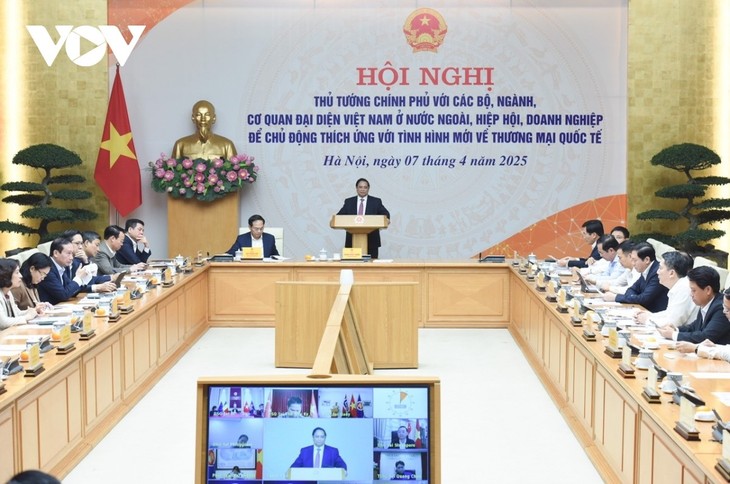(VOVWORLD) - Right after the US announced new universal tariffs on imports, Vietnam responded with flexible and appropriate actions. Party General Secretary To Lam talked by phone with US President Donald Trump on April 4. Prime Minister Pham Minh Chinh chaired a number of meetings to seek political, diplomatic, and economic solutions to the US’s new tariffs.
 Prime Minister Pham Minh Chinh chairs the meeting with ministries, diplomatic missions, associations, and businesses on solutions to cope with the US's new tariffs. (Photo: VOV) Prime Minister Pham Minh Chinh chairs the meeting with ministries, diplomatic missions, associations, and businesses on solutions to cope with the US's new tariffs. (Photo: VOV) |
Over the last few days, leaders of the Party and State have held numerous meetings, working sessions, and phone calls to discuss ways to cope with the US import tariffs that aim to ensure mutual benefit.
Short-term measures
The Vietnamese government’s general stance is to handle the issue with a holistic approach, covering both tariff and non-tariff measures. The goal is to find the most effective, flexible, and creative solutions. Vietnam is pursuing negotiations for fair and balanced tariffs on selected goods, combining political, diplomatic, economic, investment, and trade tools, and engaging domestic and foreign enterprises, including American FDI businesses operating in Vietnam, in finding appropriate negotiation strategies.
Ministries and sectors have been assigned specific tasks. The Ministry of Industry and Trade is leading efforts to study US policies to find ways to increase imports of American goods that Vietnam needs or finds beneficial, and to accelerate negotiations for upgrading the Vietnam-US Bilateral Trade Agreement.
The Ministry of Finance is tasked with reviewing tariff policies to make sure Vietnam’s import-export preferential tariffs align with the agreement between General Secretary To Lam and President Donald Trump.
Prime Minister Chinh asked Vietnamese diplomatic missions abroad to closely monitor developments and propose solutions to help the current situation.
Over the past two months, the Vietnamese government has proactively addressed the US administration’s trade concerns. Leaders of the Party, State, and ministries have contacted the US through political and diplomatic channels. In early March, PM Chinh had a three-hour meeting with US business leaders. Vietnam has resolved several US concerns, including reducing import tariffs on 23 product lines and creating more favorable conditions for American businesses. Vietnam has also pushed to balance trade by purchasing more goods from the US.
Reforms and strengthening internal capacity
Alongside tariff talks with the US, Vietnam has been accelerating efforts to diversify markets, products, and supply chains by tapping free trade agreements, improving product quality, and expanding its foothold in traditional and emerging export markets. These efforts are tied to growth in the circular economy, digital economy, and green economy.
The Prime Minister has urged businesses to boost trade promotion, stay united, and explore high-potential markets like the Middle East, Central Asia, Africa, and northeast Asia. Relevant ministries have been asked to improve visa policies. Economists say this is an opportunity for Vietnam to expand and “refresh” traditional markets by upgrading standards, quality, and branding.
In the long term, Vietnam will strengthen national competitiveness by investing in infrastructure, human capital, and innovation. At a conference with ministries, diplomatic missions, associations, and businesses on Monday, PM Chinh stressed the goal of building an independent and self-reliant economy that is deeply, practically, and effectively integrated into the global economy.
“Our economy is transitioning. We’re still a developing country with a modest economic size. That’s why every disruption can also be seen as an opportunity. Despite the challenges, this is a chance to restructure the economy, to grow stronger, to become more self-reliant, and to mature,” said Mr. Chinh.
Vietnam’s swift response to US tariffs is sending a clear message that it is working closely with the US to boost two-way trade in a way that benefits both sides and supports global economic integration.